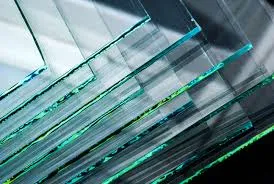Types of Architectural Glass An Overview
Architectural glass is a crucial material used in modern construction, greatly influencing aesthetics, functionality, and energy efficiency in buildings. This versatile material comes in various types, each serving unique purposes and characteristics. Understanding the different types of architectural glass can help architects, builders, and consumers make informed decisions when designing structures.
1. Float Glass
Float glass is the most common type of glass used in construction. It's made by floating molten glass on top of molten metal, typically tin. This method produces a smooth and uniform surface, making it ideal for windows and facades. Float glass can be treated further to enhance its strength and thermal performance, such as the application of low-emissivity (Low-E) coatings to reduce heat loss.
2. Laminated Glass
Laminated glass consists of two or more layers of glass sandwiched together with an interlayer, usually made of polyvinyl butyral (PVB). This interlayer not only enhances safety by holding fragments together in case of breakage but also provides sound insulation and UV protection. Laminated glass is often used in locations prone to severe weather conditions or as a safety feature in high-rise buildings.
3. Tempered Glass
Tempered glass is treated through a process of extreme heating and rapid cooling, making it significantly stronger than regular glass. This type of glass is four to five times more durable than untreated glass and is less likely to shatter, as it breaks into small, blunt pieces instead of sharp shards. It's commonly used in glass doors, shower enclosures, and facades where safety is a primary concern.
4. Insulated Glass Units (IGUs)
types of architectural glass
Insulated glass units consist of two or more glass panes separated by a spacer and sealed to create an insulated barrier. This design helps reduce thermal transfer, making IGUs highly efficient for climate control in buildings. They often incorporate Low-E coatings and argon or krypton gas between panes to improve insulation further. IGUs are commonly used in residential and commercial windows.
5. Low-E Glass
Low-E (low-emissivity) glass is coated with a thin layer of metallic oxide that reflects heat while allowing light to pass through. This energy-efficient glass helps mitigate heat loss in winter and reduces solar heat gain in summer, leading to decreased energy costs for heating and cooling. Low-E glass is invaluable for sustainable building practices and is widely used in both residential and commercial applications.
6. Patterned Glass
Patterned glass features decorative textures or designs, providing both privacy and aesthetic appeal. This type of glass is often used in bathroom windows, office partitions, and architectural features. The patterns can diffuse light while obscuring visibility, making them a popular choice for creating stylish yet functional spaces.
7. Smart Glass
Smart glass, also known as switchable glass, can change its properties in response to electrical stimuli. This innovative glass can shift from transparent to translucent, allowing users to control light and heat transmission. Smart glass is particularly utilized in high-tech buildings, improving energy efficiency and enhancing occupant comfort.
Conclusion
The variety of architectural glass types available today enables architects and builders to create structures that are not only functional and safe but also visually striking. From the commonplace float glass to the futuristic smart glass, each type of architectural glass has distinct advantages that cater to specific needs in modern construction. As trends evolve toward sustainability and energy efficiency, the role of innovative glass solutions in architecture will only continue to grow. Understanding these options allows stakeholders to leverage the best materials for their projects, ultimately enhancing the built environment.
 Afrikaans
Afrikaans  Albanian
Albanian  Amharic
Amharic  Arabic
Arabic  Armenian
Armenian  Azerbaijani
Azerbaijani  Basque
Basque  Belarusian
Belarusian  Bengali
Bengali  Bosnian
Bosnian  Bulgarian
Bulgarian  Catalan
Catalan  Cebuano
Cebuano  Corsican
Corsican  Croatian
Croatian  Czech
Czech  Danish
Danish  Dutch
Dutch  English
English  Esperanto
Esperanto  Estonian
Estonian  Finnish
Finnish  French
French  Frisian
Frisian  Galician
Galician  Georgian
Georgian  German
German  Greek
Greek  Gujarati
Gujarati  Haitian Creole
Haitian Creole  hausa
hausa  hawaiian
hawaiian  Hebrew
Hebrew  Hindi
Hindi  Miao
Miao  Hungarian
Hungarian  Icelandic
Icelandic  igbo
igbo  Indonesian
Indonesian  irish
irish  Italian
Italian  Japanese
Japanese  Javanese
Javanese  Kannada
Kannada  kazakh
kazakh  Khmer
Khmer  Rwandese
Rwandese  Korean
Korean  Kurdish
Kurdish  Kyrgyz
Kyrgyz  Lao
Lao  Latin
Latin  Latvian
Latvian  Lithuanian
Lithuanian  Luxembourgish
Luxembourgish  Macedonian
Macedonian  Malgashi
Malgashi  Malay
Malay  Malayalam
Malayalam  Maltese
Maltese  Maori
Maori  Marathi
Marathi  Mongolian
Mongolian  Myanmar
Myanmar  Nepali
Nepali  Norwegian
Norwegian  Norwegian
Norwegian  Occitan
Occitan  Pashto
Pashto  Persian
Persian  Polish
Polish  Portuguese
Portuguese  Punjabi
Punjabi  Romanian
Romanian  Russian
Russian  Samoan
Samoan  Scottish Gaelic
Scottish Gaelic  Serbian
Serbian  Sesotho
Sesotho  Shona
Shona  Sindhi
Sindhi  Sinhala
Sinhala  Slovak
Slovak  Slovenian
Slovenian  Somali
Somali  Spanish
Spanish  Sundanese
Sundanese  Swahili
Swahili  Swedish
Swedish  Tagalog
Tagalog  Tajik
Tajik  Tamil
Tamil  Tatar
Tatar  Telugu
Telugu  Thai
Thai  Turkish
Turkish  Turkmen
Turkmen  Ukrainian
Ukrainian  Urdu
Urdu  Uighur
Uighur  Uzbek
Uzbek  Vietnamese
Vietnamese  Welsh
Welsh  Bantu
Bantu  Yiddish
Yiddish  Yoruba
Yoruba  Zulu
Zulu 

